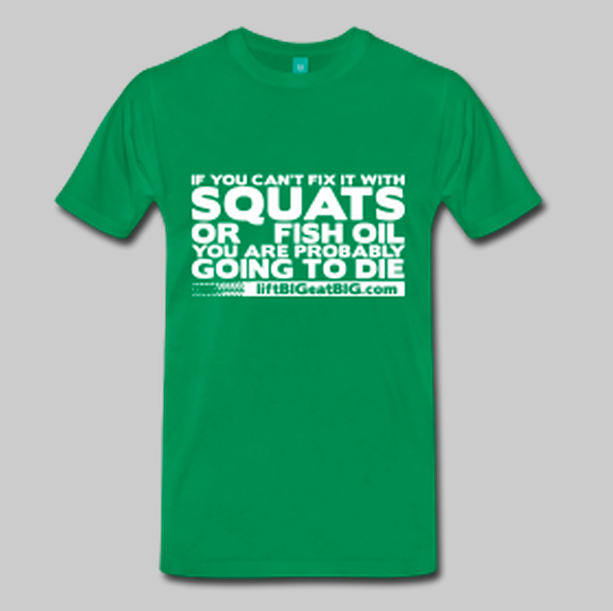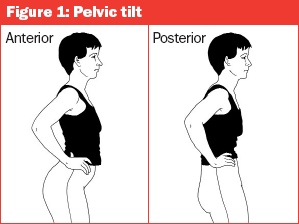Do I Need To Back Squat?
It doesn’t matter whether you want bigger legs, a faster sprint, massive biceps, a cure for Ebola or a non pharmaceutical alternative to Viagra. If you approach most fitness professionals with these goals they’ll likely tell you to do back squats.
-

Image credit: http://liftbigeatbig.spreadshirt.com/if-you-can-t-fix-it-with-squats-or-fish-oil-A13689080
All jokes aside, the recommendation to back squat is, in my opinion, thrown about far too much without consideration of the actual individual and their capabilities. This leads everyone to believe that the exercise is an absolute must when actually there may be a potentially better alternative.
However, it pains me to admit that the back squat isn’t useful in all cases like some would make it out to be.
Why?
It has a special place in my heart as my favourite exercise, probably because it’s the one I’m best at! I’ve got near perfect Hobbit like levers for it with short femurs and a long torso, meaning that I’m quite biomechanically blessed in this particular movement, with a not too shabby (but far from world record breaking) 235kg squat at 83kg bodyweight. Some individuals however, would not be as suited to squatting as myself, perhaps with their longer femur length.
Notice in the video below how I can get deep with such little forward lean, meaning I’ve got good levers for squatting:
I wish I could say the same about my poverty deadlift strength however, but I digress…
Let’s take a look at why you should at least consider whether back squatting is the best movement of choice for you.
1. It’s more technical than you think.
Squatting properly isn’t just a case of whacking a bar on your shoulders, unracking it, taking a few steps back, dropping down and standing back up again.
There are several nuances involved that must at least be considered if you are to squat safely, and lift a lot of weight in doing so. This goes beyond the scope of this article, but it may involve some of the following:
- Externally rotating the femurs at the hip joint.
- Maintaining thoracic extension and proper positioning of the shoulders throughout the movement.
- Simultaneous extension of the knees and hips to recover from the bottom position.
These things takes time to learn, practice and master.
Let’s be honest, not everyone has the time nor the inclination to do this. So why not save yourself a bit of bother and choose, or at least consider a less technical alternative that will still get you just as good, if not better results?
2. Not everyone is built to back squat (with good form).
Those with long femurs (thigh bones) and certain structured hip sockets can’t get into a ideal position with a relatively upright torso, along with the knees aligned out over the feet.
When someone can’t get into a good squat position, a lot of trainers or coaches will prescribe stretching/mobility work and strengthening/activating of certain muscle groups in order to do so.
In some cases this will work, but unfortunately if an issue is related to joint or bone structure, no amount of stretching or activation work will improve or correct it! Unless you like the feeling of grinding in your joints, it is largely pointless in this scenario.
A quick (sort of) related story here… I once tried to gain sufficient mobility to do the splits, because for some weird reason I wanted to be like Jean Claude Van-Damme in Kickboxer. After a couple of months of improving and easing into the stretch, I felt like there was a “bony block” in my hips, and I couldn’t get past this point. No matter hard I try, there’s likely no way I’m going to get past this because my hips are not “designed” to be able to do the splits!
The people who aren’t genetically gifted with perfect levers, limb length and joint structure can absolutely still squat (and may do so fine without injury) but this may involve a much more angled forward torso, which may put stress on the lower back, which leads me on to my next point.
3. It can put unnecessary stress on the body.
Depending on the technique and style in which you perform them, not only can squats put a fair bit of stress on the lower back, they can also potentially tax the knees and shoulders in an undesirable way too.
This may be fine if as a powerlifter, weightlifter or strongman you’re prepared to take the risks and can afford the time to take proper precautions to recover. However, other sports, such as rugby can also create some serious joint stress on its own, and your body doesn’t need further stress smashing it to pieces even more!
So if you’re carrying a few niggles, or play a sport that involves a lot of joint stress, it’s potentially a better idea to choose some other exercises.
4. It is not essential for performance or increasing muscle mass.
There’s no doubting that back squats load the quads, glutes, lower back to name just a few, and do so in one nice tidy package of an exercise, giving them an incredible bang for your buck.
There’s also a decent body of evidence suggesting that back squats correlate well with jump performance and sprint speed, amongst other performance markers that are important in almost ALL sports.
As they say however, there is more than one way to skin a cat.
The only group of people it’s actually essential for is in powerlifters, as it’s 100% specific to their sport!
On another note, a commonly cited reason for the inclusion of squats in training programs is their beneficial effects on increasing anabolic hormones in the body such as growth hormone and testosterone.
There is evidence that this is true, but what there isn’t evidence for however, is that these short term spikes in these hormones actually translate into any meaningful gains in muscle mass or performance, as the levels seem to return back to baseline in a relatively short space of time.
5. There are a ton of (potentially) better alternatives to get the same benefit.
There are plenty of top level athletes, bodybuilders and your average Joes that have got jacked quads, massive hamstrings, powerful glutes and incredible sport performances thanks to performing back squats.
However, there are also many people who have achieved amazing performances and physiques without ever having touched a back squat.
If you’re after bigger legs, more lower body power or glutes that you could bounce a coin off, there are a ton of alternatives to performing back squats that will still move you towards your goals.
A few back squat alternatives include:
- Leg pressing, double and single leg
- Split squats
- Rear foot elevated split squats
- Front squats
- Skater squats
- Trap bar deadlifts
- Snatch grip deadlifts
- Hack squats
- Prowler/sled pushes
- Prowler/sled backward drags
Having said all of the above, it does not mean that you SHOULDN’T back squat.
It just means that squats have a risk:reward ratio (as do every other exercise) that you should consider when choosing whether to perform them or not.
Have you decided the risks outweigh the potential for reward?
Do something else.
If not, back squat to your heart’s content!




